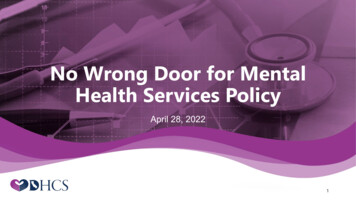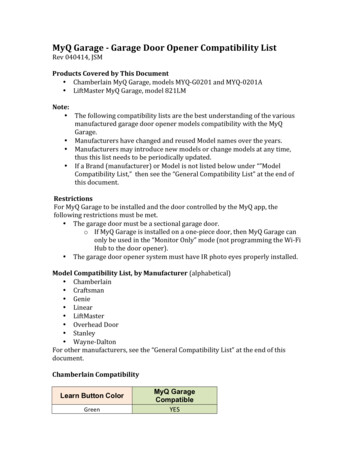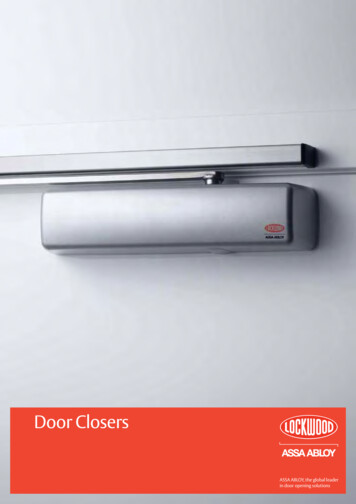
Transcription
No Wrong Door for MentalHealth Services PolicyApril 28, 20221
HousekeepingParticipants are in listen only mode.Please submit questions via the Q&A function. The Chatfeature is disabled.Live closed captioning is available – you can find the link inthe Chat.The webinar slides and recording will be posted to the DHCSCalAIM webpage – please see the link in the Chat.
Welcome and Introductions3
DHCSPresenters»»Tyler Sadwith, Assistant DeputyDirector, Behavioral HealthJillian Clayton, Chief, QualityPolicy and Coordination Section,Managed Care Quality &Monitoring Division
AgendaBrief PHE UpdateLearning ObjectivesBackgroundNo Wrong Door PolicyImplementation & ComplianceQ&A
Public Health Emergency (PHE) Unwinding» The COVID-19 PHE will end soon and millions ofMedi-Cal beneficiaries may lose their coverage.» Top Goal of DHCS: Minimize beneficiary burden and promotecontinuity of coverage for our beneficiaries.» How you can help:» Become a DHCS Coverage Ambassador» Download the Outreach Toolkit on the DHCS Coverage Ambassadorwebpage» Join the DHCS Coverage Ambassador mailing list to receive updatedtoolkits as they become available6
DHCS PHE Unwind CommunicationsStrategy Phase One: Encourage Beneficiaries to Update Contact Information Launch immediately Multi-channel communication campaign to encourage beneficiaries to updatecontact information with county offices.» Flyers in provider/clinic offices, social media, call scripts, website banners Phase Two: Watch for Renewal Packets in the mail. Remember toupdate your contact information! Launch 60 days prior to COVID-19 PHE termination. Remind beneficiaries to watch for renewal packets in the mail and updatecontact information with county office if they have not done so yet.7
Webinar ObjectivesProvide backgroundand context for NoWrong DoorEnsure understandingof the No WrongDoor policyProvide opportunityfor stakeholders toask implementationand compliancequestionsOutline next steps
CalAIM Behavioral Health Initiatives TimelineGo-LivePolicyDateCriteria for Specialty Mental Health ServicesJan. 2022Drug Medi-Cal Organized Delivery System 2022-2026Jan. 2022Drug Medi-Cal ASAM Level of Care DeterminationJan. 2022Updated Annual Review Protocol and Reasons for Recoupment FY 2021-2022 Jan. 2022Documentation Redesign for Substance Use Disorder & Specialty MentalJul. 2022Health ServicesNo Wrong Door & Co-Occurring TreatmentJul. 2022Updated Annual Review Protocol and Reasons for Recoupment FY 2022-2023 Oct. 2022Standardized Screening & Transition ToolsJan. 2023Behavioral Health CPT Coding TransitionJul. 2023County Behavioral Health Plans Transition to Fee-for-Service andJul. 2023Intergovernmental TransfersAdministrative Behavioral Health IntegrationJan.9 2027Jan. 2027
What is the aim of the No Wrong Door(NWD) for Mental Health Services Policy?To ensurebeneficiaries receivetimely mental healthservices without delayregardless of wherethey initially seek careTo ensurebeneficiaries canmaintain treatmentrelationships withtrusted providerswithout interruption.10
How did DHCS develop the NWD policy?WorkgroupsCalAIM Proposal2019-2020 CalAIMstakeholderworkgroupsdemonstrated theneed to ensurebeneficiaries havestreamlinedaccess to servicesand treatment.CalAIM proposalreleased for publiccomment Jan 2021.CalAIM Section 1115Amendmentsubmitted June2021.AB 133 chapteredJuly 2021.NWD PublicCommentDraft policyreleased inJanuary 2022.DHCS reviewedand integratedstakeholderfeedback.Final PolicyReleased in March2022 viaBHIN 22-011andAPL 22-005.
Medi-Cal Mental Health Services:Division of ResponsibilityManagedMentalHealth PlansCare PlansRequired to provideor arrange for theprovision of SMHSfor beneficiaries intheir counties whomeet access criteriafor SMHS. SMHS: Specialty Mental Health Services NSMHS: Non-Specialty Mental Health ServicesRequired to provideor arrange for theprovision ofNSMHS formembers whomeet access criteriafor NSMHS.
Who does No Wrong Door impact?Medi-Cal beneficiaries of all ages receiving or seeking specialtymental health services (SMHS) and/or non-specialty mentalhealth services (NSMHS)» Access criteria for SMHS is outlined in BHIN 21-073» Access criteria for NSMHS is outlined APL 22-006
No Wrong Door PolicyClinically appropriate and covered NSMHS and SMHS services arecovered and reimbursable Medi-Cal services even when:Services are provided prior to determination of a diagnosis, duringthe assessment period, or prior to determination of whether NSMHSor SMHS access criteria are met;The beneficiary has a co-occurring mental health condition andsubstance use disorder (SUD);Services are not included in an individual treatment plan*; OR*Applies to NSMHS per APL; SMHS guidance forthcoming via BHDocumentation ReformNSMHS and SMHS services are provided concurrently, if thoseservices are coordinated and not duplicated.
Services Covered During AssessmentServices are covered and reimbursable even when providedduring the assessment period prior to the determination ofa diagnosis or prior to determination of whether accesscriteria are met:» Clinically appropriate SMHS and NSMHS are covered andreimbursable during the assessment process prior todetermination of a diagnosis or a determination that thebeneficiary meets SMHS or NSMHS criteria, respectively.» SMHS and NSMHS provided during the assessment processare covered even if the assessment ultimately determines thebeneficiary does not meet criteria for SMHS or NSMHS.
Co-Occurring Services are CoveredServices are covered and reimbursable whether or notthe beneficiary has a co-occurring mental health andsubstance use disorder (SUD):» SMHS: Clinically appropriate SMHS delivered by MHPproviders are covered whether or not the beneficiary has a cooccurring SUD.» DMC Services: Clinically appropriate and covered DMC &DMC-ODS services are covered by DMC counties and DMCODS counties, respectively, whether or not the beneficiary hasa co-occurring mental health condition.» NSMHS: Clinically appropriate NSMHS are covered Medi-Calservices via the FFS and MCP delivery systems, whether or notthe beneficiary has a co-occurring mental health condition.
Concurrent NSMHS and SMHS are CoveredConcurrent NSMHS & SMHS» Beneficiaries may concurrently receive NSMHS via an FFS or MCPprovider and SMHS via a MHP provider when the services areclinically appropriate, coordinated, and not duplicative.» When a beneficiary meets criteria for both NSMHS and SMHS, thebeneficiary should receive services based on individual clinicalneed and established therapeutic relationships.» Beneficiaries with established relationships with an FFS or MCPprovider may continue receiving NSMHS from the provider, even ifsimultaneously receiving SMHS from an MHP provider and viceversa as long as the services are coordinated and non-duplicative.
How will MHPs and MCPsimplement NWD?»»»DHCS issued policy guidance to MCPs via All Plan Letter(APL) 22-005DHCS issued policy guidance to MHPs via BHIN 22-011MHPs and MCPs will need to review and revise existingPolicies and Procedures (P&Ps) and Memorandums ofUnderstanding (MOUs) to ensure compliance with NWD.» Note: DHCS will be revising its MOU requirements perCalAIM and other recent policy changes. Updated MOUsare due to DHCS by November 1st, 2022.
»How will DHCS trackcompliance with NWD?DHCS will review updated P&Ps and MOUs» MHPs shall implement the No Wrong Door policies,update policies and procedures and memoranda ofunderstanding with MCPs and communicate updates toproviders effective July 1, 2022. MHPs shall submitupdated No Wrong Door P&Ps with September 30, 2022BHQIP report.» MCPs should submit updated P&Ps to their contractmanager within 90 days of the release of the APL, MCPsare responsible to comply with the policy outlined in theAPL.» Service delivery disputes between MHPs and MCPs mustbe addressed consistent with DHCS guidance and in theMOUs between MCPs and MHPs.
How does NWD align withother CalAIM policy changes?»»NWD builds upon the updated access criteria for SMHS andNSMHS.» Access Criteria For SMHS BHIN 21-073» Defines criteria for beneficiary access to SMHS,medical necessity and other coverage requirements.» MCP Responsibilities for NSMHS APL 22-006» Defines beneficiary access criteria and MCPresponsibilities for NSMHSStandard screening and transition tools will be implementedin January 2023 and will help streamline NWD.
Access Criteria for SMHSprovided by MHPsAccessCriteria BHIN 21-073Access Criteria for NSMHSprovided by MCPs APL 22-005 APL 22-006
SMHS Criteria for Beneficiaries 21 Beneficiary has one or both:» Significant impairment, where impairment is defined asdistress, disability, or dysfunction in social, occupational, orother important activities. AND/OR» A reasonable probability of significant deterioration in animportant area of life functioning.AND the condition is due to either:» A diagnosed mental health disorder, according to the criteriaof the DSM and the ICD. OR» A suspected mental disorder not yet diagnosed.22
SMHSCriteria forBeneficiariesunder 21»Covered specialty mental healthservices shall be provided toenrolled beneficiaries who meeteither of the following criteria(referred to as Criteria 1 andCriteria 2 in the following slides).23
SMHSCriteria forBeneficiariesunder 21:Criteria 1»The beneficiary has a conditionplacing them at high risk for amental health disorder due toexperience of trauma evidencedby any of the following: scoringin the high-risk range under atrauma screening tool approvedby the department, involvementin the child welfare system,juvenile justice involvement, orexperiencing homelessness. OR24
SMHS Criteria for Beneficiaries under 21: Criteria 2The beneficiary meets both of the following requirements:»The beneficiary has at least one of the following:»A significant impairment and/or»A reasonable probability of significant deterioration in an important area of lifefunctioning and/or»A reasonable probability of not progressing developmentally as appropriate and/or»A need for specialty mental health services, regardless of presence of impairment,that are not included within the mental health benefits that a Medi-Cal managedcare plan is required to provide.AND»The beneficiary’s condition as described above is due to one of the following:» A diagnosed mental health disorder, according to the criteria of the currenteditions of the Diagnostic and Statistical Manual of Mental Disorders and theInternational Statistical Classification of Diseases and Related Health Problems or» A suspected mental health disorder that has not yet been diagnosed and/or» Significant trauma placing the beneficiary at risk of a future mental healthcondition, based on the assessment of a licensed mental health professional.25
Updated Medical Necessity for SMHS» Medical necessity for SMHS services is now defined exclusivelyat WIC Section 14059.5:» (a) For individuals 21 years of age or older, a service is “medicallynecessary” or a “medical necessity” when it is reasonable and necessaryto protect life, to prevent significant illness or significant disability, or toalleviate severe pain.» (b) (1) For individuals under 21 years of age, a service is “medicallynecessary” or a “medical necessity” if the service meets the standardsset forth in Section 1396d(r)(5) of Title 42 of the United States Code.
Mental Health Plans: Required SMHSRehabilitative Mental Health Services, including mental health services; medicationsupport services; day treatment intensive; day rehabilitation; crisis intervention andstabilization; and adult and crisis residential treatment servicesPsychiatric health facility servicesPsychiatric inpatient hospital servicesTargeted case managementEPSDT supplemental SMHS (for individuals under age 21)Katie A services, including Intensive Care Coordination (ICC), Intensive HomeBased services (IHBS),Therapeutic Behavioral Services (TBS, and Therapeutic FosterCare (TFC) (for individuals under age 21)Source: 2017-2022 MHP Contract Exhibit A
NSMHSAccessCriteriaMembers who are 21 years of age and older with mild tomoderate distress, or mild to moderate impairment ofmental, emotional, or behavioral functioning resultingfrom mental health disorders, as defined by the currentDiagnostic and Statistical Manual of Mental Disorders;Members who are under the age of 21, to the extent theyare eligible for services through the Medicaid Early andPeriodic Screening, Diagnostic, and Treatment (EPSDT)benefit, regardless of the level of distress or impairment, orthe presence of a diagnosis; and,Members of any age with potential mental healthdisorders not yet diagnosed.
»»Access Assurances for Beneficiaries under 21In accordance with Welfare and Institutions Code (WIC) Sections 14059.5 and14184.402, for individuals under 21 years of age, a service is “medically necessary”or a “medical necessity” if the service meets the EPSDT standard set forth inSection 1396d(r)(5) of Title 42 of the United States Code (U.S.C.). The federal EPSDTmandate requires states to furnish all appropriate and medically necessary servicesthat are coverable under a Medicaid State Plan (as described in 42 U.S.C. Section1396d(a)) as needed to correct or ameliorate health or behavioral healthconditions discovered by a screening service, regardless of whether those servicesare covered in the state’s Medicaid State Plan.Behavioral health services, including NSMHS, need not be curative or completelyrestorative to ameliorate a behavioral health condition. Services that sustain,support, improve, or make more tolerable a behavioral health condition areconsidered to ameliorate the condition, are thus medically necessary, and are thuscovered as EPSDT services.
Managed Care Plans: Required NSMHSMental health evaluation and treatment, including individual, group and familypsychotherapyPsychological and neuropsychological testing, when clinically indicated toevaluate a mental health conditionOutpatient services for purposes of monitoring drug therapyPsychiatric consultationOutpatient laboratory, drugs*, supplies and supplements*Excludes medications covered under the Medi-Cal Rx Contract Drug List,which can be accessed at: https://medi-calrx.dhcs.ca.gov/home/cdl/
»Managed ons for addiction treatment (MedicationAssisted Treatment) provided in primary care,inpatient hospital, emergency departments, andother contracted medical settingsProvide or arrange for the provision of MAT inprimary care, inpatient hospital, ED, etc.Alcohol and drug screening, assessments, briefinterventions, and referral to treatment forbeneficiaries ages 11 and older, includingpregnant women, in primary care settings andtobacco, alcohol, illicit drug screeningEmergency stabilization and emergency roomprofessional services as described in Section53855 of Title 22 of CCRB
»NextSteps»MHPs and MCPs should begin meeting torevise MOUs and P&Ps based on NWD APL/INguidance and forthcoming MOU guidance.Technical Assistance:» DHCS will offer technical assistance andpeer-to-peer learning opportunities forMCPs and MHPs to support No WrongDoor implementation.» Webinars will begin inJune. Stay tuned for moredetails!» DHCS will publish FAQs, asneeded, to support policyimplementation.
Q&A
» If you have questions,Questions?please e-mail DHCS at:BHCalAIM@dhcs.ca.govand/orMCQMD@dhcs.ca.gov» Subject Line “No WrongDoor Policy”
Thank You35
Appendix36
» MOU TemplateAdditionalReferences»» Memorandum of Understandingbetween MHP and MCP identifying eachparty’s responsibilities and obligationsto each other.» DHCS is currently updating MOUrequirements to be released in mid2022./APL 18-015/Attachment2» Describes the responsibilities of MCPsfor amending or replacing MOU withMHPs for coordination of Medi-Calmental health servicesAPL 15-015Attachment 2
MHPs shall implement the No Wrong Door policies, update policies and procedures and memoranda of understanding with MCPs and communicate updates to providers effective July 1, 2022. MHPs shall submit updated No Wrong Door P&Ps with September 30, 2022 BHQIP report. » MCPs should submit updated P&Ps to their contract manager










